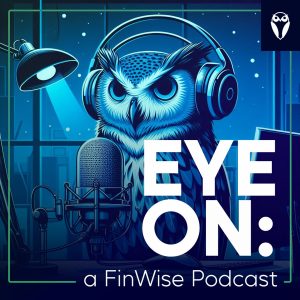
Chris Comber, SVP, Credit Management & Strategy at FinWise Bank
As we enter the final quarter of 2025, we analyze trends that have set the tone for lending in the 2025 fiscal year. Several key trends that have shaped the lending environment in recent history have been driven by evolving macroeconomic conditions, advancements in technology, and a shifting regulatory environment. AI-powered automation, rise of embedded financing, and volatility in interest rates were among the most influential factors across consumer, small business and commercial lending sectors.
Technology & Automation Trends.
Lenders have been increasingly adopting AI to improve current risk management processes, fraud detection, in addition to real-time risk assessments. In this large-scale adoption, challenges remain including data privacy, regulatory compliance, and the underlying risk of bias in AI models. Even with apparent risks and little comprehensive AI regulation as it relates to the banking industry, regulators expect banks to use a risk-based approach with existing laws and principles, ensuring AI applications are safe, fair, and transparent. The regulatory landscape is evolving, with various agencies issuing guidance, analyzing risks, and beginning to address AI-specific concerns.
After acknowledging potential risks and regulatory interpretations, the financial service industry is quickly working to adopt forms of AI as a focus of both cost reduction and revenue growth. It was estimated in a report from Acrew Capital and Money 20/20 that 76% of Financial Services companies have launched AI initiatives. Companies such as Upstart, a Strategic Partner of FinWise Bank, have long been on the bandwagon of adopting AI to support their lending platform.
Upstart is an online lending platform founded in 2012 that uses AI to connect borrowers with over 100 banks and credit unions for personal loans, ranging from $1,000 to $50,000. The lending platform uses AI and machine learning to leverage a wider range of data points than traditional credit models. The alternative data currently encompasses 1,600 data points to create a holistic borrower profile, including factors such as education, employment history, and financial behaviors. The AI is then implemented to identify creditworthy applicants who might be rejected by traditional models. In some analysis, this has led to a higher rate of approvals and lower average interest rates for borrowers.
In addition to large scale adoption of AI molding the forefront of fintech innovation is the growing popularity of embedded financing. Embedded lending is the seamless integration of credit and financing services directly into non-financial platforms, such as e-commerce websites, software-as-a-service (SaaS) providers, and mobile apps. This technology allows customers to access financing at the point of need without being redirected to a third-party lender, creating a more convenient and contextual experience. The embedded Finance Market is estimated to be valued at 85.8 billion for 2025 with projections reaching 370.9 billion by 2035, resulting in a compound annual growth rate of 15.8% during the forecast period from research reports produced by “future market insights”. The consumer adoption of this technology offering can be seen in the recent performance of Affirm, who offers a “buy now, pay later” (BNPL) service that allows customers to finance purchases by splitting the cost into flexible payment plans, with options for 0% APR or simple interest rates on monthly installments. Affirm reported a 24% increase in active consumers to 23 million and a 20% rise in the transaction frequency of its users. The company’s active merchants also grew to 377,000 by the end of June 2025. This directly correlated with the firm’s improved financial performance where the company posted a net profit of $52 million for the 2025 fiscal period, a significant turnaround from its $518 million net loss the previous year.
Technology and automation in banking will continue to be a pivotal focus of the changing financial services industry. Through the adoption and use of robotic process automation, artificial intelligence, and machine learning institutions can streamline repetitive, rule-based tasks such as data entry, transaction processing, and customer service requests. This acknowledgement of benefits was also ushered in by growing pressures in the banking industry to modernize payment systems, enhance security, and deliver more efficient and customizable offerings that are reflective of the growing number of fintech companies entering the market. Through this increasing need for innovation, we expect bank strategic partnerships to continually grow to enable faster adoption of consumer needs for technological development and more personalized credit offerings.
Economic & Market Trends.
Despite interest rate concessions by the Federal Reserve in 2025, long-term rates and mortgage rates remained elevated and volatile. This has caused constrained affordability, especially for mortgages, and has been cited by banks as a reason for tightening lending standards. This constraint among consumers is reflective of the significant growing credit card debt for US consumers. As of Q2 2025, credit card debt has reached a record high of $1.2 trillion. This rise is predominantly driven by persistent inflation and high interest rates. These conditions have also increased consumer usage for “buy now, pay later”, or BNPL loans to cover everyday expenditures. Stated in a recent LendingTree survey, a quarter of Americans now use BNPL loans to pay for groceries, up 14% from last year. Additionally, consumers who have reported student loans are now outside of the pandemic forbearance period which ended in September 2023, bringing millions of borrowers back into repayment with their pre-pandemic balances. In turn, the student loan delinquency rate has surged dramatically, with recent data from May 2025 showing nearly 8% of student debt in “serious delinquency” (90+ days past due). This is a sharp increase from the <1% pre-pandemic rate with some estimating it could reach 30% or higher. These attributes have directly affected the private consumer lending industry which has been described as robust growth driven by banks tightening their standards.
This shift has enabled the private lending industry to experience significant growth with the unsecured personal loan market hitting new heights. As of Q1 2025, total balances reached $253 billion across nearly 30 million loans per TransUnion’s newly released Q1 2025 Credit Industry Insights Report (CIIR). This growth is driven by rising new loan originations, particularly from fintech lenders. Fintech firms have been able to capture a larger share of the market by offering online-only lending experiences with fintechs accounting for almost 50% of new account balances for personal loans at the end of the 2024 fiscal year. In contrast, the commercial and industrial loan demand has seen weaker demand. The slowdown has been mostly attributed to economic and policy uncertainty, leading businesses to postpone growth-related capital expenditures.
We expect demand to remain at elevated levels for the personal consumer loan market driven by growing desires for flexible credit terms that can aid in constraining budgets of US citizens that have been primarily driven by persistent inflation, increasing costs of essential goods and services, and the accumulation of other debts. The demand for commercial and industrial loan requests is estimated to remain constant throughout the remaining fiscal year with anticipation of increased demand in 2026 driven by a more stable economic outlook, potential interest rate cuts, and significant commercial real estate refinancing needs.
Regulatory & Compliance Trends.
Under the new administration, federal regulators like the Consumer Financial Protection Bureau prioritized cases showing clear consumer harm and reduced some examinations. In the early part of 2025, Chief Legal Officer Mark R. Paoletta, outlined the CFPB’s new supervision and enforcement priorities. This included reduction in supervisory exams, shift back to depository institutions, focus on actual fraud, and redress for tangible harm. The CFPB’s new priorities reflect a significant shift in focus, emphasizing collaboration with supervised entities, reducing regulatory burdens, and targeting tangible consumer harms. However, this has led to more active enforcement of fair lending law by state-level regulators. Additionally, the House has overturned CFPB rules on overdraft products and digital payment oversight, and Republicans on the House Financial Services Committee have proposed cutting the CFPB’s funding. Enforcement is being refocused on active service members and veterans, with increased reliance on state-level consumer protection.
Additionally, the current administration has pursued a deregulatory agenda, primarily focused on preventing “politicized debanking” and rolling back regulations from the previous administration. An executive order signed in August 2025 aims to prevent financial institutions from denying services based on political or religious beliefs or lawful business activities. Key actions include directing federal regulators to remove “reputational risk” from guidance and examination manuals, investigating financial institutions for unlawful debanking policies, developing a strategy to combat politicized debanking, and requiring the Small Business Administration to identify and attempt to reinstate clients previously denied services.
2025 has also seen several specific regulatory changes take effect, including the CFPB’s rule limiting reporting of medical debt to credit agencies and a pared-back version of the Payday Lending Rule. Other regulations, like the requirement for collecting small business lending data under Section 1071, were paused or planned for a rewrite. We currently estimate that further rollbacks are possible under the administration but expect Anti-money laundering (AML) and Know Your Customer (KYC) regulations to become more stringent as financial crimes grow more sophisticated and global money laundering continues to aggregate to amounts of $2 trillion annually based on research produced by United Nations Office on Drugs & Crime (UNODC).
References:
1. Embedded finance market size and CAGR – https://www.futuremarketinsights.com/reports/embedded-finance-market
2. Personal Loan Debt: https://newsroom.transunion.com/q1-2025-ciir/ – https://money.usnews.com/loans/personal-loans/articles/personal-loan-statistics-and-trends
3. Regulatory & Compliance Trends: https://www.consumerfinancialserviceslawmonitor.com/2025/04/cfpb-announces-2025-supervision-and-enforcement-priorities/
4. Global Money Laundering: https://www.unodc.org/unodc/en/money-laundering/overview.html
Connect with FinWise Bank.
Upcoming 2025 Events
- October 26-29 – Money 20/20 2025 Las Vegas
- November 19-20, 2025 – Fintech Nerdcon Miami
Join us on a FinWise Podcast found here:
 |
 |
 |
|---|
